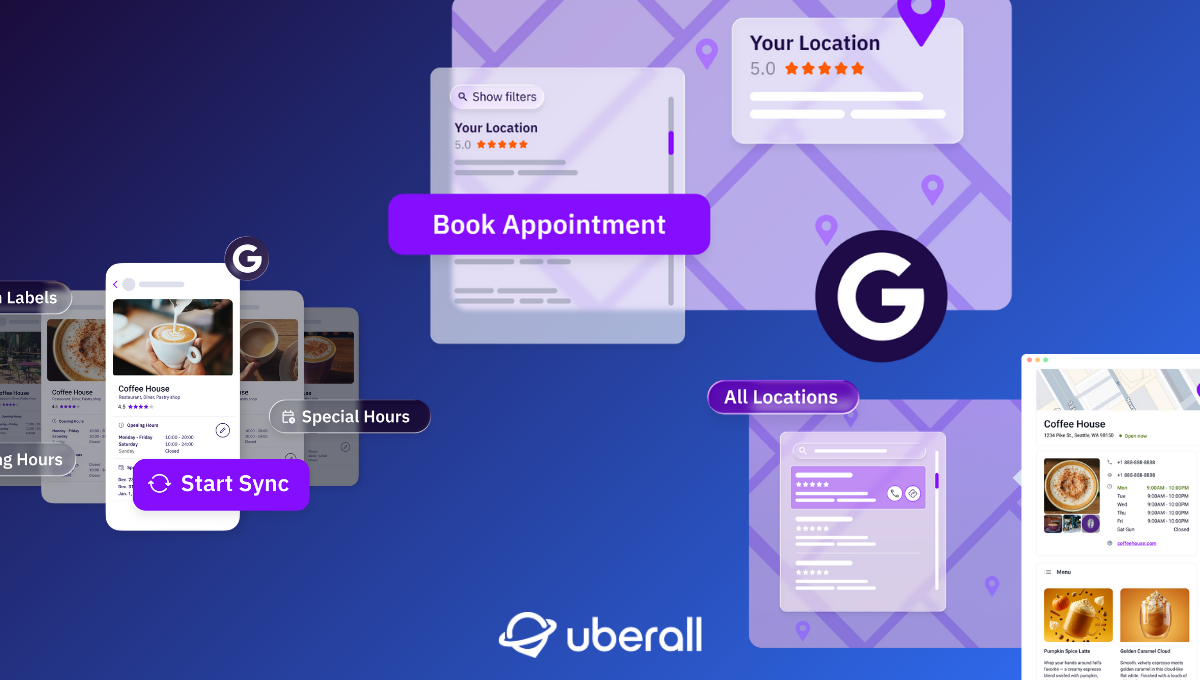
How to Optimize EV Charging Stations on Google Maps
We’ll guide you in how to optimize your Google Maps presence, ensuring your EV charging stations stand out in online search among competitors.
The increasing number of searches for “electric vehicle charging station” is exciting for the EV industry, indicating a growing EV adoption and demand for charging solutions. However, many EV businesses have yet to fully optimize their online presence.
While drivers increasingly rely on Google Maps to find charging stations, not all charge point operators (CPO) are capitalizing on Google Business Profile to capture their attention. In this blog, we will guide you on how to optimize your Google presence, ensuring your charging stations stand out in online searches.
Why Google Maps Matters for EV Businesses
EV drivers rely on Google Maps to locate charging stations, plan routes, and make real-time decisions. In fact, searches for “electric vehicle charging station” on Google have grown by 80% in recent years, reflecting the growing dependency of drivers on this platform for their charging needs:
- Over 200K searches/month in the United States
- Over 200K searches/month in the United Kingdom
So, prominent listings on Google Search and Google Maps—by means of a Google Business Profile—can significantly influence the number of visitors to your EV charging station. Google even introduced features specifically designed to assist EV drivers, showing:
- nearby charging station
- types of chargers
- power of chargers
- charging speed
- the number of ports
This information answers the most urgent questions like “Is it the charger I need” and “Is it available now?” as well as those tied to the customer experience like “Does it accept my payment method?” and “What amenities are nearby while I wait?”.
And unlike Apple Maps, which also provides charging station information, Google Maps offers more detailed local data and user-generated content
Key Elements of Google Maps Optimization for CPOs
You likely already have a Google Business Profile and are just here to fine-tune it—but if not, let’s start from scratch.
Step 0: Set up a Google Business Profile (GBP)
To set up a Google Business Profile (GBP), visit Google Business and sign in with your account. After adding key information like your business name, address and phone number (NAP data), you’ll have to complete the verification process via postcard, video, phone, or email to make your listing live and visible on Google Maps. This part can be tricky for CPO’s as postcard verification is not suitable. Applying for bulk verification is the best option.
Step 1: Complete Your Listing
To optimize your Google Business Profile, start by ensuring that your profile is complete. Besides your NAP data, this includes:
- Location Details: Provide precise addresses and GPS coordinates to ensure drivers can easily find your station.
- Operating Hours: List the hours of operation and any special times (e.g., holidays) when the station may be closed.
- Charger Types: Share the types of chargers available (e.g., fast chargers, Level 2 chargers) and their specifications.
Also, ensure all information is regularly updated and consistent with listings on other platforms. This increases the likelihood of drivers choosing your station over others—and helps you avoid customer frustration and potential negative reviews.
These data points are provided by your backend system (this is where the EV data lives) and fed directly to Google Maps through the GELFS protocol. You’ll need to make that connection directly or work with a data aggregator such as EcoMovement.

Step 2: Select Categories & Attributes
Selecting the right categories and attributes is crucial for improving search visibility. Use “Electric Vehicle Charging Station” as the main category and information about payment options (e.g. credit card, mobile payment), amenities (e.g. restrooms, dining options) or accessibility (e.g. 24/7) as attributes.
Same comment as above, these data points are provided by your backend system (this is where the EV data lives) and fed directly to Google Maps through the GELFS protocol. You’ll need to make that connection directly or work with a data aggregator such as EcoMovement.
Step 3: Add a Description and Photos
A detailed description and high-quality images are essential for making your listing appealing and trustworthy. Include:
- Description: Highlight key features such as fast charging capabilities, accessibility options and any special services, which can attract specific types of EV drivers.
- Photos: Show the chargers, the layout of your station, and any amenities (e.g., waiting areas, restrooms) to give drivers a better impression of your stations.
For instance, a well-written description that emphasizes fast charging capabilities and a comfortable waiting area can attract more drivers. Or maybe you’re using renewable energy, which makes your station special—or you’re located at an EV hyperhub.
Step 4: Offer Real-Time Information
Keeping your listing updated with real-time information about your chargers is vital, and unique to the EV industry. Implement features such as:
- Live Updates: Provide real-time updates on the availability of chargers.
- Status Alerts: Include alerts (in the form of posts) about any issues or maintenance.
This transparency helps manage charge anxiety, allowing drivers to rely on your charging network without concerns about availability.
Again, these data points are provided by your backend system (this is where the EV data lives) and fed directly to Google Maps through the GELFS protocol. You’ll need to make that connection directly or work with a data aggregator such as EcoMovement.
Step 5: Leverage Reviews and Ratings
User reviews and ratings play a significant role in Google Maps rankings and influence driver decisions. According to a BrightLocal study, 88% of consumers trust online reviews as much as personal recommendations, underscoring the importance of managing your station’s online reputation.
Encouraging Positive Reviews
To encourage satisfied customers to leave positive reviews, focus on providing an excellent service that ensures a smooth and enjoyable charging experience. Then use in-station prompts, such as signs or QR codes, to remind users to leave reviews, or follow up with polite emails requesting feedback after their visit.
Managing Negative Reviews
To handle negative reviews effectively, respond promptly and professionally. Begin by acknowledging issues with empathy and a readiness to resolve problems. Offer practical solutions or compensations where applicable to address the concerns.
By managing negative feedback effectively, you not only maintain a positive reputation but also transform potentially damaging situations into opportunities to highlight your commitment to excellent customer service.
Step 6: Use Google Features
Google Maps offers several features to enhance your listing–like Google Posts to share updates, promotions, or news about your charging stations as well as FAQs to answer users’ urgent questions.
Plugging into Success: Local SEO Q&A for CPOs
Enhancing Visibility with Local SEO
To boost your charging station’s visibility on Google Maps and improve its ranking, it's essential to focus on key local SEO practices.
- NAP Consistency: Ensure that your name, address, and phone number (NAP) are consistent across all online platforms, including your GBP, website, social media, and other relevant EV directories. This helps Google verify your business details, improving your local search rankings and making it easier for customers to find your station.
- Use of Local Keywords: Integrate location-based keywords such as “EV charging station near [City]” or “best electric vehicle chargers in [Area]” into your GBP profile and website content. These keywords help Google understand your listing, aligning it with relevant search queries and enhancing its visibility in local search results.
- Regular Updates and Engagement: Keep your GBP profile up-to-date by posting updates about changes in operating hours, new services, or special promotions. Regular updates and active engagement signal to Google that your listing is relevant and current, which can positively impact your ranking.
Besides, there’s a few things that Google values in particular:
- Relevance: Ensuring that your charging station’s description and keywords accurately reflect its services and location helps Google match your listing to relevant local searches, increasing its visibility.
- Proximity: Google prioritizes listings that are closest to the user’s current location, so optimizing your profile with precise location details and local keywords can improve your ranking in search results.
- Prominence: Building a strong online presence through positive reviews, high engagement, and consistent information across platforms enhances your station’s prominence, making it more likely to rank higher in local search results.
Moreover, incorporating structured data, like schema markup, can boost your visibility by providing Google with detailed information about your charging station.
EV SEO Best Practices
"If you’re not quite ready to dive in, start by exploring best practices that have already proven successful for others. The following examples from Uberall customers offer valuable insights into search engine optimization, specifically tailored for Google and the EV industry.
EWE Go optimized their location listings by ensuring accurate and consistent data across multiple platforms, which significantly improved visibility especially on Google. Moreover, the team implemented real-time updates to provide the latest information about their charging stations, enhancing customer experience.
Orlen emphasized maintaining up-to-date and consistent business listings while actively managing reviews. Their strategy of responding promptly to customer feedback and ensuring accurate location details drove increased engagement and reliability for their charging stations.
Conclusion
As the EV market expands, so does the need for effective EV marketing strategies. However, it can be overwhelming to determine where to start with your marketing efforts. With so many (ranking) factors to consider, you need a solution that helps you focus on what matters most without wasting time.
so does the need for effective EV marketing strategies. However, it can be overwhelming to determine where to start with your marketing efforts. With so many (ranking) factors to consider, you need a solution that helps you focus on what matters most without wasting time.
Uberall’s platform offers that kind of a centralized solution, allowing you to optimize for local search quickly and efficiently. Partnering with Eco-Movement, it helps enhance your visibility on Google Maps and other key platforms, ensuring that your charging station is easily found by potential customers.Curious? Reach out to learn more about how to maximize your profit through local SEO!
Ready to Transform Your Business?
Connect with our partnership team to learn how Uberall can help you achieve similar results. Get a personalized consultation and discover the opportunities waiting for your business.
Resources











